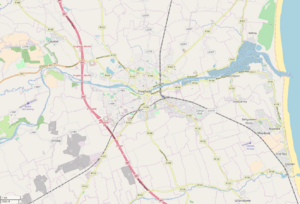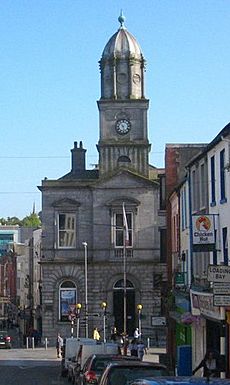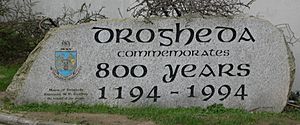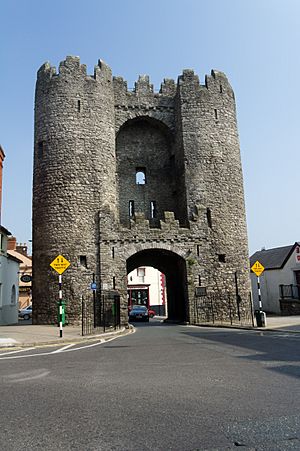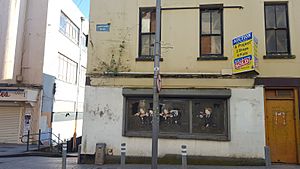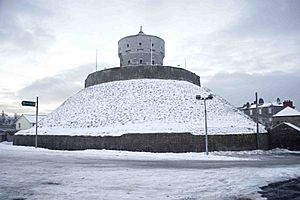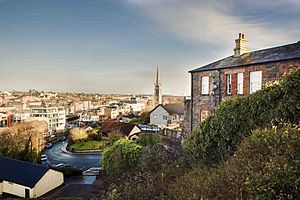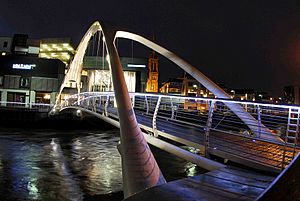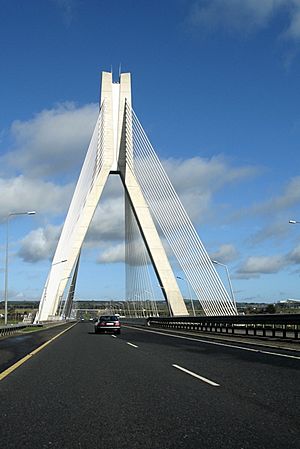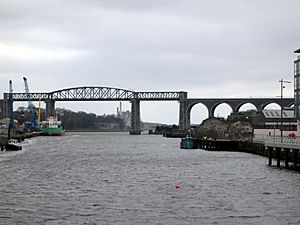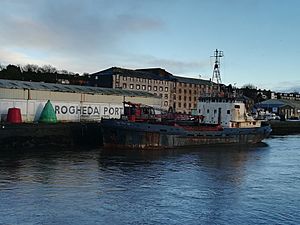Drogheda facts for kids
Quick facts for kids
Drogheda
Droichead Átha
|
|||
|---|---|---|---|
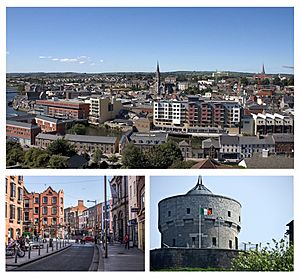
Clockwise from top: Drogheda viewed from the south; Millmount Fort; West Street, Drogheda
|
|||
|
|||
| Motto(s):
"God Our Strength, Merchandise Our Glory."
|
|||
| Country | Ireland | ||
| Province | Leinster | ||
| County | County Louth and County Meath | ||
| Municipal district | Drogheda Borough District | ||
| Founded | 911 AD | ||
| First Charter | 1194 | ||
| County Status | 1412 (Abolished 1898) | ||
| Area | |||
| • Total | 14.8 km2 (5.7 sq mi) | ||
| Highest elevation | 27 m (89 ft) | ||
| Lowest elevation | 1 m (3 ft) | ||
| Population
(2022 census)
|
|||
| • Total | 44,135 | ||
| • Rank | 6th | ||
| • Density | 2,776.6/km2 (7,191/sq mi) | ||
| • Greater area | 83,000 | ||
| Demonyms | Droghedean, Boynesider | ||
| Time zone | UTC±0 (WET) | ||
| • Summer (DST) | UTC+1 (IST) | ||
| Eircode routing key |
A92
|
||
| Telephone area code | +353(0)41 | ||
Drogheda (pronounced "DRO-həd-ə" or "DRAW-də") is a busy town with a port on the east coast of Ireland. Its name in Irish, Droichead Átha, means "bridge at the ford". It's about 43 kilometers (27 miles) north of Dublin. Most of Drogheda is in County Louth, but a small part in the south is in County Meath.
In 2022, Drogheda had a population of 44,135 people. This makes it the largest town in Ireland by population and area. It's also the last place where you can cross the River Boyne before it flows into the Irish Sea. The famous UNESCO World Heritage Site of Newgrange, an ancient tomb, is only 8 kilometers (5 miles) west of the town.
Drogheda started as two separate towns in different areas. One part was in Meath, and the other was in what was then called Uriel (now County Louth). This division happened because of an old boundary between two Irish kingdoms. In 1412, the two towns joined together. Drogheda was chosen to host Fleadh Cheoil na hÉireann, a big traditional Irish music festival, in both 2018 and 2019.
Contents
History of Drogheda
Ancient Times and Early Settlements
The area around Drogheda has many old archaeological sites. These include large passage tombs like Newgrange, Knowth, and Dowth, which are thousands of years old. Discoveries during building projects show that people have lived in this area for a very long time.
How the Town Began
Historians believe Drogheda didn't exist before the Normans arrived. One of the oldest buildings is the motte-and-bailey castle, now known as Millmount Fort. It sits on a hill overlooking the town and was likely built by the Norman Lord of Meath, Hugh de Lacy, before 1186. The oldest stone wall in Drogheda, on Rosemary Lane, was part of a castle built in 1234.
The first known town charter, which gave Drogheda certain rights, was given in 1194. Drogheda was an important walled town in the English Pale during the medieval period. It often hosted meetings of the Irish Parliament. In 1494, a very important law called Poynings' Law was passed here. This law meant that the Irish Parliament needed the English King's approval for its laws.
Important Later Events
Drogheda was attacked twice during the Irish Confederate Wars. In 1649, Oliver Cromwell and his army took the town. This was part of the Cromwellian conquest of Ireland.
The Battle of the Boyne, a very famous battle in Irish history, happened about 6 kilometers (4 miles) west of Drogheda in 1690, along the River Boyne. The old town hall, The Tholsel, was finished in 1770.
In 1790, the Drogheda Harbour Commissioners were set up to manage the port. Later, in 1825, the Drogheda Steam Packet Company started, offering shipping services to Liverpool.
Town Symbols (Coat of Arms)
Drogheda's coat of arms shows St. Laurence's Gate with three lions. It also has a ship coming out from both sides of the gate. The town's motto, Deus praesidium, mercatura decus, means "God our strength, merchandise our glory."
The star and crescent symbol on the coat of arms has an interesting story. Some say it was added after the Great Famine to thank the Ottoman Sultan for sending food supplies to Ireland, which arrived in Drogheda. While some historians thought this was a myth, later evidence suggests that Turkey did help Ireland during the Famine.
Drogheda Today
In recent years, some older parts of Drogheda's town center have faced challenges. Some buildings have become empty. There have been plans to make West Street, a main shopping area, better for walking. Local people hope that changes will bring more shoppers and businesses back to the town center. The Westgate area of Drogheda is set for a 10-year plan to make it new again.
People of Drogheda (Demographics)
Drogheda is home to many people. In 2022, there were 44,135 people living in the town. The wider area around Drogheda has over 70,000 people.
In 2016, about 17.4% of the people living in Drogheda were from other countries. The largest groups were from Poland and Lithuania, as well as many people from other EU countries and beyond.
Arts and Entertainment
Music Scene
Drogheda has been a big center for traditional Irish music. It hosted the national Fleadh Cheoil na hÉireann festival in 2018 and 2019, bringing musicians from all over Ireland and the world.
The town also has two brass bands: Drogheda Brass Band and Lourdes Brass Band. In 2014, Drogheda hosted an international summer Samba festival, with samba bands drumming and parading through the streets.
Michael Holohan, a well-known composer, lives in Drogheda. His music has been played and broadcast widely. Drogheda also has "Music at the Gate," a community event with live music near Saint Laurence's Gate. The Drogheda Arts Festival, with music, performances, and street entertainment, happens every May.
Visual Arts
In 2006, the Highlanes Gallery opened. This was the first art gallery in Drogheda dedicated to showing art to the public. It's in an old Franciscan Church and holds Drogheda's art collection, which dates back to the 1600s.
Places to Visit
Drogheda is an old town with many interesting places to see. It's close to the UNESCO World Heritage site of Newgrange, which is an amazing ancient monument. Other places to visit include:
- Millmount Fort and museum: An old fort with great views of the town.
- Saint Laurence Gate barbican gate: A large, impressive gate from the 1300s.
- John Philip Holland memorial: A sculpture honoring the inventor of the modern submarine.
- Boyne Viaduct: A huge railway bridge over the River Boyne.
- Battle Of The Boyne Site: A visitor center at the famous battle site.
- Beaulieu House and Gardens: A beautiful historic house and gardens.
- Mellifont Abbey: The ruins of an old monastery.
- Townley Hall nature trail and woods: A lovely place for a walk in nature.
- Princess Grace Rose Garden at St. Dominic's Park: A park with many beautiful roses.
- St. Peter's Roman Catholic Church: Home to a special shrine of Oliver Plunkett.
- St Peter's Church of Ireland church: Another historic church on Peter's Hill.
- Highlanes Gallery: The town's main art gallery.
- Augustinian Church: Features a famous stained-glass window called 'The Passion Window' by Harry Clarke.
Businesses and Economy
Many international companies have offices or factories in the Drogheda area. Some of the big employers include Coca-Cola International Services, State Street International Services, Natures Best, and the Drogheda Port Company.
Drogheda also has a long history of making drinks. Companies like Jameson Whiskey, Guinness, and Jack Daniel's have connections to the town. Today, you can find local distilleries and breweries like Boann distillery and Slane Whiskey.
In recent years, Drogheda has seen a lot of new buildings, including apartments, shops, and houses. More than 1000 new homes are expected to be built in 2024.
Getting Around (Transport)
Roads
Drogheda is located near the M1 motorway, which is the main road connecting Dublin and Belfast. The Mary McAleese Boyne Valley Bridge carries the M1 over the River Boyne, just west of the town. This bridge, opened in 2003, is the longest cable-stayed bridge in Ireland.
Trains
Drogheda got its first train connections in the 1840s. You can take trains from Drogheda railway station north to places like Dundalk and Belfast, or south to Dublin Connolly and other towns. There are plans to extend the DART train service to Drogheda in the future.
Buses
Drogheda's bus station is on Donore Road. You can catch buses to places like Monaghan and Dublin.
How Drogheda is Governed
Drogheda used to have its own special local government called a borough corporation. In 2014, the town's administration joined with Louth County Council. However, Drogheda still has the right to be called a borough. The person in charge of the borough district is called the mayor.
Drogheda also has its own areas for local elections, choosing 10 people to represent the town on the county council. For national elections, Drogheda is part of the Louth area, which elects members to the Irish Parliament (Dáil Éireann).
News and Radio
Drogheda has two local newspapers, the Drogheda Leader and the Drogheda Independent. Both are published every week. The local radio station is LMFM, which broadcasts on 95.8 FM.
Schools
Drogheda has seven secondary schools for teenagers. These include all-boys schools, all-girls schools, and mixed schools. There is also the Drogheda Institute for Further Education (DIFE), which offers college-level courses.
Sports
Drogheda is home to the association football (soccer) team, Drogheda United. They were formed in 1919 and play their home games at Head In The Game Park. They are nicknamed "The Drogs" and won the League of Ireland Premier Division for the first time in 2007. They have also won the FAI Cup and the Setanta Sports Cup. In 2011, Drogheda United became a sister club to the Turkish club Trabzonspor because of their similar team colors and the historical connection between Drogheda and the Ottoman Empire.
In rugby union, the local team is Boyne RFC. They were formed in 1997.
Sister Cities
Drogheda has "sister city" relationships with other towns around the world. These are:
- Bronte, Italy
- Saint-Mandé, France
- Salinas, California, United States
Famous People from Drogheda
Arts and Media
- Pierce Brosnan: A famous actor, known for playing James Bond.
- Evanna Lynch: An actress known for her role as Luna Lovegood in the Harry Potter films.
- Colin O'Donoghue: An actor known for playing Captain Hook in the TV show Once Upon a Time.
- Hector Ó hEochagáin: A popular broadcaster and podcaster.
- Nano Reid: A painter famous for her landscapes of Drogheda and the Boyne Valley.
- Fiachra Trench: A composer who wrote music for many Hollywood movies.
Science and Innovation
- John Philip Holland: The inventor of the modern submarine.
Sports Stars
- Evan Ferguson: A professional footballer who plays for Brighton & Hove Albion in the Premier League.
- Ian Harte: A former footballer who played for several English clubs and the Republic of Ireland national team.
- Gary Kelly: A football player and charity worker.
- Des Smyth: A professional golfer.
- Steve Staunton: A former Liverpool and Aston Villa defender, and captain and manager of the Republic of Ireland national football team.
Freedom of the Town
Some special people have been given the "Freedom of the Town" of Drogheda. This is a very high honor. Some of them include:
- Charles Stewart Parnell: A famous Irish political leader.
- Éamon de Valera: A former President of Ireland.
- Pope John Paul II: The head of the Catholic Church.
- John Hume: A Nobel Peace Prize winner.
- Michael D. Higgins: The current President of Ireland.
Images for kids
See also
 In Spanish: Drogheda para niños
In Spanish: Drogheda para niños






